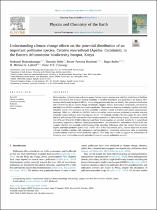| dc.contributor.author | Mukundamago, Mukundi | |
| dc.contributor.author | Dube, Timothy | |
| dc.contributor.author | Mudereri, Bester Tawona | |
| dc.date.accessioned | 2024-02-14T09:35:24Z | |
| dc.date.available | 2024-02-14T09:35:24Z | |
| dc.date.issued | 2023 | |
| dc.identifier.citation | Mukundamago, M., Dube, T., Mudereri, B.T., Babin, R., Lattorff, H.M.G. and Tonnang, H.E., 2023. Understanding climate change effects on the potential distribution of an important pollinator species, Ceratina moerenhouti (Apidae: Ceratinini), in the Eastern Afromontane biodiversity hotspot, Kenya. Physics and Chemistry of the Earth, Parts A/B/C, 130, p.103387. | en_US |
| dc.identifier.issn | 14747065 | |
| dc.identifier.uri | http://dx.doi.org/10.1016/j.pce.2023.103387 | |
| dc.identifier.uri | http://hdl.handle.net/10566/9302 | |
| dc.description.abstract | Monitoring key pollinator taxa such as the genus Ceratina requires precise near real-time predictions to facilitate better surveillance. The potential habitat suitability of Ceratina moerenhouti was predicted in the Eastern Afromontane biodiversity hotspot (EABH) in Kenya using presence-only data, to identify their potential distribution and vulnerability due to climate change. Bioclimatic, edaphic, terrain, land surface temperature, and land use and land cover (LULC) variables were used as predictors. Three machine learning techniques, together with their ensemble model, were evaluated on their suitability to predict current and future (the shared socioeconomic pathways (SSPs), i.e., SSP245 and SSP585) habitat suitability. Predictors were subjected to variable selection using the variance inflation factor resulting in a few (n = 9) optimum variables. The area under the curve (AUC) and true skill statistic (TSS) were used for the accuracy assessment of the modeling outputs. The results indicated that 30% and 10% of the EABH in Murang'a and Taita Taveta counties are currently suitable for C. moerenhouti occurrence, respectively. However, future projections show a ±5% decrease in C. moerenhouti habitats in the two counties. Further, the ensemble model harnessed the algorithm differences while the random forest had the highest individual predictive power (AUC = 0.97; TSS = 0.96). Clay content, LULC, and the slope were the most relevant variables together with temperature and precipitation. Integrating multi-source data in predicting suitable habitats improves model prediction capacity. This study can be used to support the maintenance of flowering plant communities around agricultural areas to improve pollination services. | en_US |
| dc.language.iso | en | en_US |
| dc.publisher | Elsevier Ltd | en_US |
| dc.subject | Climate variability | en_US |
| dc.subject | Landscape dynamics | en_US |
| dc.subject | Pollinator | en_US |
| dc.subject | Niche modeling | en_US |
| dc.subject | Ceratina | en_US |
| dc.title | Understanding climate change effects on the potential distribution of an important pollinator species, ceratina moerenhouti (apidae: ceratinini), in the eastern afromontane biodiversity hotspot, Kenya | en_US |
| dc.type | Article | en_US |

